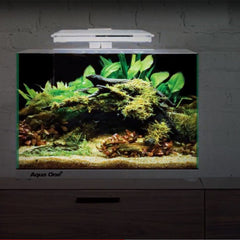
In the world of aquascaping, a new trend is making waves - nano tanks. These miniature tanks, often no larger than a shoebox, are taking the aquarium world by storm, captivating hobbyists and nature enthusiasts alike. But what exactly makes these nano tanks so special?
Nano tanks allow aquascapers to create stunning miniature worlds, complete with lush aquatic vegetation, intricate hardscape designs, and a diverse array of colorful fish and invertebrates. Their compact size makes them perfect for any space, whether you live in a small apartment or want to add a touch of nature to your office desk.
With their low maintenance requirements and affordable price tag, nano tanks offer a gateway into the fascinating world of aquascaping for beginners. They require less water, fewer resources, and provide the same creative outlet for hobbyists to express their artistic vision.
In this article, we will delve into the beauty of miniature worlds and explore why nano tanks have become the latest trend in aquascaping. Discover the secrets behind their popularity and learn how to create your own captivating nano tank masterpiece. Get ready to be inspired by the beauty and intricacy of these tiny aquatic landscapes.
What are nano tanks?
Nano tanks are small aquariums typically ranging from 14L in size. They are designed to provide a compact and manageable space for aquascaping enthusiasts to create stunning underwater landscapes. Despite their small size, nano tanks offer endless possibilities for creativity and design.
One of the key features of nano tanks is their portability. Their compact nature allows them to fit in any space, making them perfect for small apartments, offices, or even as a decorative centerpiece on a dining table. Nano tanks are also more affordable compared to larger aquariums, making them accessible to both beginners and experienced aquascapers.
Nano tanks are often made from high-quality glass or acrylic, ensuring durability and providing a clear view of the aquatic environment. They come in various shapes, including cubes, rectangles, and bowfront designs, allowing aquascapers to choose the tank that best suits their aesthetic preferences.
The rise of nano tanks in aquascaping
In recent years, nano tanks have gained immense popularity in the world of aquascaping. This rise in popularity can be attributed to several factors that make nano tanks an attractive choice for both beginners and experienced aquascapers.
One of the main reasons for the surge in nano tank popularity is their low maintenance requirements. Nano tanks require less water, fewer resources, and are easier to clean compared to larger aquariums. This makes them ideal for busy individuals or those who are new to the hobby and want to start with a smaller, more manageable tank.
Another advantage of nano tanks is their affordability. Setting up a nano tank requires a smaller initial investment compared to larger aquariums, as they require less equipment, fewer decorations, and a smaller volume of water. This makes them a budget-friendly option for aquascapers who want to explore the world of aquascaping without breaking the bank.
Additionally, nano tanks offer a unique challenge for experienced aquascapers. The limited space of a nano tank forces aquascapers to think creatively and strategically when designing their miniature underwater landscapes. This challenge pushes aquascapers to explore new techniques and experiment with innovative design ideas, resulting in stunning and awe-inspiring nano tank creations.
Benefits of nano tanks in aquascaping
Nano tanks offer a range of benefits that make them an attractive choice for aquascapers of all levels. Here are some of the key advantages of using nano tanks in aquascaping:
1. Space-efficient: Nano tanks are perfect for small living spaces, such as apartments or offices, where larger aquariums may not be feasible. Their compact size allows aquascapers to create beautiful underwater landscapes without taking up too much space.
2. Low maintenance: Nano tanks require less water, fewer resources, and are easier to clean compared to larger aquariums. This makes them ideal for beginners or busy individuals who may not have the time or resources to dedicate to a larger tank.
3. Affordable: Setting up a nano tank requires a smaller initial investment compared to larger aquariums. With fewer equipment and decorations needed, nano tanks offer a budget-friendly option for aquascapers who want to explore the world of aquascaping without breaking the bank. They are a great way to see if you like aquascaping as a hobby and often lead to more aquascaped aquariums!
4. Creative expression: The limited space of a nano tank challenges aquascapers to think creatively and strategically when designing their miniature underwater landscapes. This encourages experimentation and innovation, resulting in unique and captivating aquascaping creations.
5. Versatility: Nano tanks can be used to create a wide range of aquascaping styles, from lush planted tanks to minimalist rock scapes. Their versatility allows aquascapers to explore different design techniques and create personalized underwater worlds.
Popular types of nano tanks
Nano tanks come in various shapes and sizes, each offering its own unique advantages and aesthetic appeal. Here are some popular types of nano tanks commonly used in aquascaping:
1. Nano Cubes: Nano cubes are square-shaped tanks, typically ranging from 14L. Their symmetrical design allows for easy placement of plants, rocks, and other decorative elements. Nano cubes are a popular choice for beginners as they provide a balanced and versatile canvas for aquascaping.
2. Bowfront Nano Tanks: Bowfront nano tanks feature a curved front panel, adding an elegant and visually appealing touch to the aquascape. The curved design creates an illusion of depth and enhances the overall aesthetic of the tank. Bowfront nano tanks are perfect for showcasing intricate hardscape designs and creating a sense of movement in the underwater landscape.
3. Rimless Nano Tanks: Rimless nano tanks offer a clean and minimalist look, with no visible frame around the edges. This design creates an unobstructed view of the aquatic environment and highlights the beauty of the aquascape. Rimless nano tanks are a popular choice for aquascapers who prefer a sleek and contemporary aesthetic.
4. All-in-One Nano Tanks: All-in-one nano tanks come with built-in filtration systems, making them a convenient option for beginners or those who prefer a hassle-free setup. These tanks often include LED lighting, heating, and filtration compartments, providing a complete and self-contained aquatic ecosystem.
Setting up a nano tank: equipment and essentials
Setting up a nano tank for aquascaping requires careful consideration of the equipment and essentials needed to create a thriving aquatic environment. Here are the key components you will need to set up a successful nano tank:
1. Tank or aquarium: Choose a nano tank that suits your space and aesthetic preferences. Consider factors such as size, shape, and material (glass or acrylic) when selecting a tank. Ensure that the tank is watertight and free from any defects. Most nano aquariums come complete with lighting filtration. We recommend the Aqua One Focus 36 Glass Aquarium 36L to start aquascaping with, this comes complete with LED lighting and filter.
2. Lighting: Proper lighting is essential for the growth of aquatic plants in a nano tank. LED lights are a popular choice for nano tanks as they provide energy-efficient and customisable lighting options. Select lights that offer the appropriate spectrum and intensity for the plants you plan to grow.
3. Filtration: Nano tanks require proper filtration to maintain water quality and remove waste. Hang-on-back (HOB) filters or sponge filters are commonly used in nano tanks due to their compact size and efficiency. Choose a filter that can handle the volume of water in your tank and provides mechanical and biological filtration.
4. Heating: Most tropical fish and aquatic plants require a stable and controlled temperature. Select a heater that is suitable for the size of your tank and can maintain the desired temperature range.
5. Substrate: Choose a substrate that is suitable for the plants you plan to grow. Options include gravel, sand, or specialised aquatic plant substrates. Ensure that the substrate is thoroughly rinsed before adding it to the tank to remove any dust or debris.
6. Decorations: Enhance the visual appeal of your nano tank with decorations such as rocks, driftwood, or aquarium-safe ornaments. These elements not only provide aesthetic value but also serve as hiding places and territories for fish and invertebrates.
7. Plants and Fish: Select plants and fish that are compatible with the size and water parameters of your nano tank. Consider the growth requirements, behaviour, and compatibility of different species when choosing the inhabitants for your tank. Our knowledgeable staff can assist you with this.
Choosing the right plants and fish for a nano tank
Choosing the right plants and fish is crucial for the success of your nano tank. Here are some factors to consider when selecting the inhabitants for your nano tank:
1. Plants: Choose aquatic plants that are suitable for the size of your nano tank and the lighting conditions you can provide. Consider the growth rate, care requirements, and compatibility of different plant species. Popular choices for nano tanks include Java moss, Anubias, Cryptocoryne, and various types of carpeting plants.
2. Fish: Select fish species that are compatible with the size and water parameters of your nano tank. Consider the adult size, behaviour, and compatibility with other fish species. Some popular choices for nano tanks include small tetras, dwarf rasboras, guppies, endlers, and various species of dwarf shrimp.
3. Invertebrates: In addition to fish, nano tanks are also suitable for hosting a diverse array of invertebrates. Consider adding shrimp to your nano tank. These invertebrates not only add color and interest to the tank but also serve as natural cleaners by consuming algae and detritus.
Ensure that the plants and fish you choose are compatible with each other and can thrive in the conditions provided by your nano tank. Research the specific care requirements of each species to ensure a healthy and balanced ecosystem.
Maintaining a nano tank: water parameters and care
Maintaining proper water parameters is essential for the health and well-being of the inhabitants in your nano tank. Regular maintenance and monitoring are crucial to ensure a thriving aquatic environment. Here are some key aspects of nano tank maintenance:
1. Water Quality: Regularly test the water parameters of your nano tank, including temperature, pH, ammonia, nitrite, and nitrate levels. Make adjustments as necessary to maintain optimal conditions for the plants and fish.
2. Water Changes: Perform regular water changes to remove accumulated toxins and replenish essential minerals. Aim for a water change of 10-20% of the tank volume every week or as needed.
3. Algae Control: Algae can be a common issue in nano tanks due to the limited water volume and lighting intensity. Control algae growth by maintaining proper lighting duration, avoiding overfeeding, and utilising algae-eating invertebrates.
4. Plant Care: Trim and prune the aquatic plants as needed to maintain their shape and prevent overcrowding. Remove any dead or decaying plant material to prevent water quality issues. Use a co2 kit to maintain healthy growth and vibrant looking plants.
5. Fish Feeding: Feed your fish a balanced and appropriate diet, taking into consideration their specific nutritional requirements. Avoid overfeeding, as excess food can lead to water quality issues.
Regular observation and intervention are essential for maintaining a healthy and balanced nano tank. Monitor the behavior and appearance of the plants and fish, and address any issues promptly to prevent further complications.
Creative aquascaping techniques for nano tanks

Aquascaping is an art form that allows you to create captivating underwater landscapes. With nano tanks, the limited space presents a unique opportunity for creative expression. Here are some creative aquascaping techniques to enhance the beauty of your nano tank:
1. Iwagumi Style: Iwagumi is a popular aquascaping style that focuses on the arrangement of rocks to create a sense of balance and harmony. In a nano tank, the minimalist nature of the Iwagumi style can be particularly striking. Use a combination of different-sized rocks to create focal points and create a sense of depth.
2. Dutch Style: The Dutch style is characterised by its lush planting and vibrant colors. In a nano tank, the Dutch style can be achieved by densely planting various types of aquatic plants, creating a vibrant and dynamic underwater landscape.
3. Nature Aquarium Style: The Nature Aquarium style, popularized by renowned aquascaper Takashi Amano, aims to recreate the beauty of nature in the aquarium. In a nano tank, this style can be achieved by using driftwood, rocks, and carefully selected plants to create a natural-looking underwater landscape.
4. Wabi-Kusa: Wabi-Kusa is a technique that involves planting aquatic plants in a substrate ball or mesh, creating a miniature floating garden. This technique is particularly suitable for nano tanks, as it allows for easy rearrangement and experimentation with different plant combinations.
Experiment with different aquascaping techniques and find a style that resonates with your artistic vision. Remember to consider the size and shape of your nano tank when planning your aquascape, ensuring a harmonious and balanced composition.
Nano tank inspiration: showcasing stunning miniature worlds
To provide inspiration and showcase the beauty of nano tanks, here are some examples of stunning miniature worlds created by talented aquascapers:
1. The Forest Oasis: This nano tank features a lush carpet of aquatic plants, surrounded by towering rocks and driftwood. The combination of vibrant greenery and natural elements creates a serene and captivating underwater forest.
2. The Zen Garden: This minimalist nano tank utilizes carefully placed rocks and sand to create a tranquil and Zen-like atmosphere. The simplicity of the design emphasizes the beauty of negative space and the delicate balance between elements.
3. The Underwater Cityscape: This nano tank recreates a bustling cityscape underwater, complete with miniature buildings, roads, and bridges. The use of creative hardscape materials and carefully chosen fish species brings the city to life in a unique and captivating way.
4. The Colourful Coral Reef: This nano tank mimics the vibrant colours and intricate structures of a coral reef. The careful selection of coral-like plants and the addition of colourful fish species create a miniature underwater world that rivals the beauty of the ocean.
These examples demonstrate the limitless creative possibilities that nano aquariums offer. Let your imagination run wild and create your own stunning miniature world that reflects your unique vision and style.
Embracing the beauty of nano tanks in aquascaping
Nano tanks have revolutionized the world of aquascaping, offering a compact and manageable space to create stunning underwater landscapes. Their low maintenance requirements, affordability, and limitless creative potential have made them the latest trend in aquascaping.
Whether you're a beginner looking for an introduction to the world of aquascaping or an experienced aquascaper seeking a new challenge, nano tanks are well worth the effort!
© weknowpets 2024









